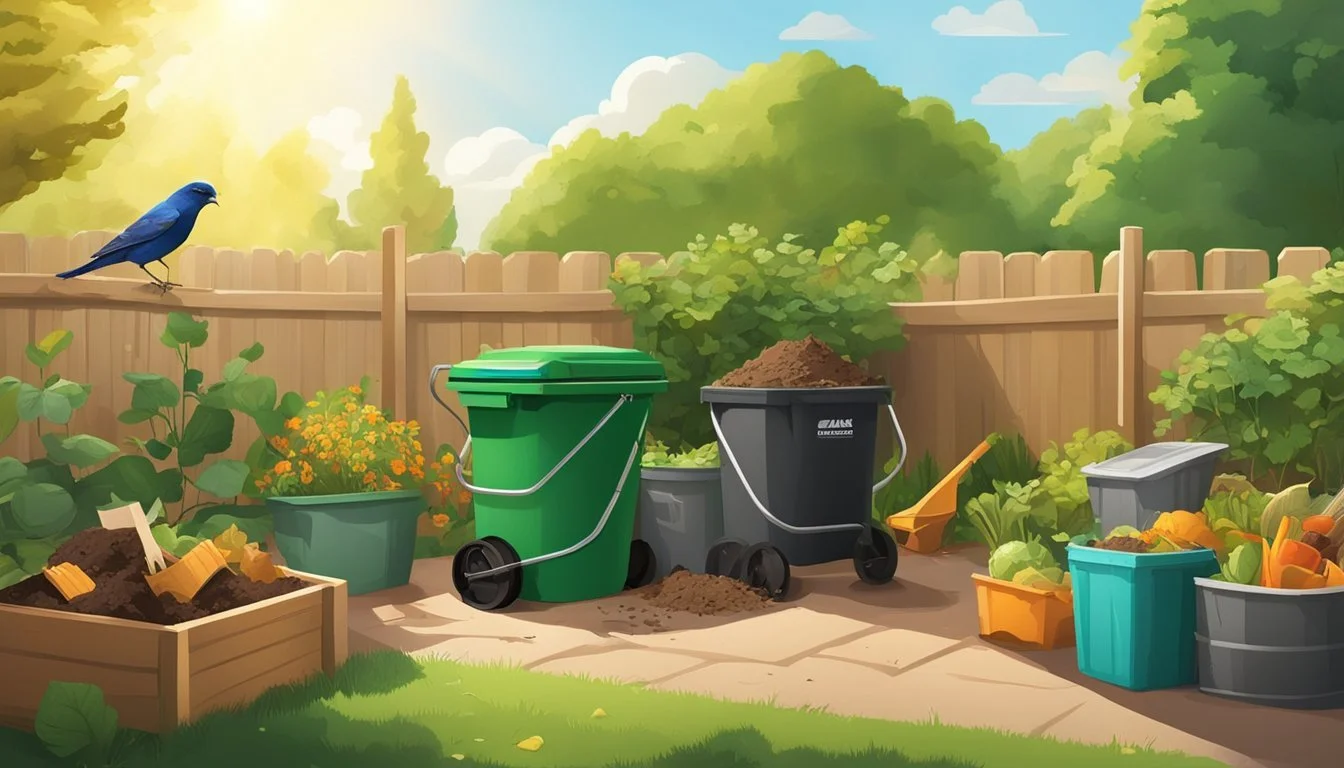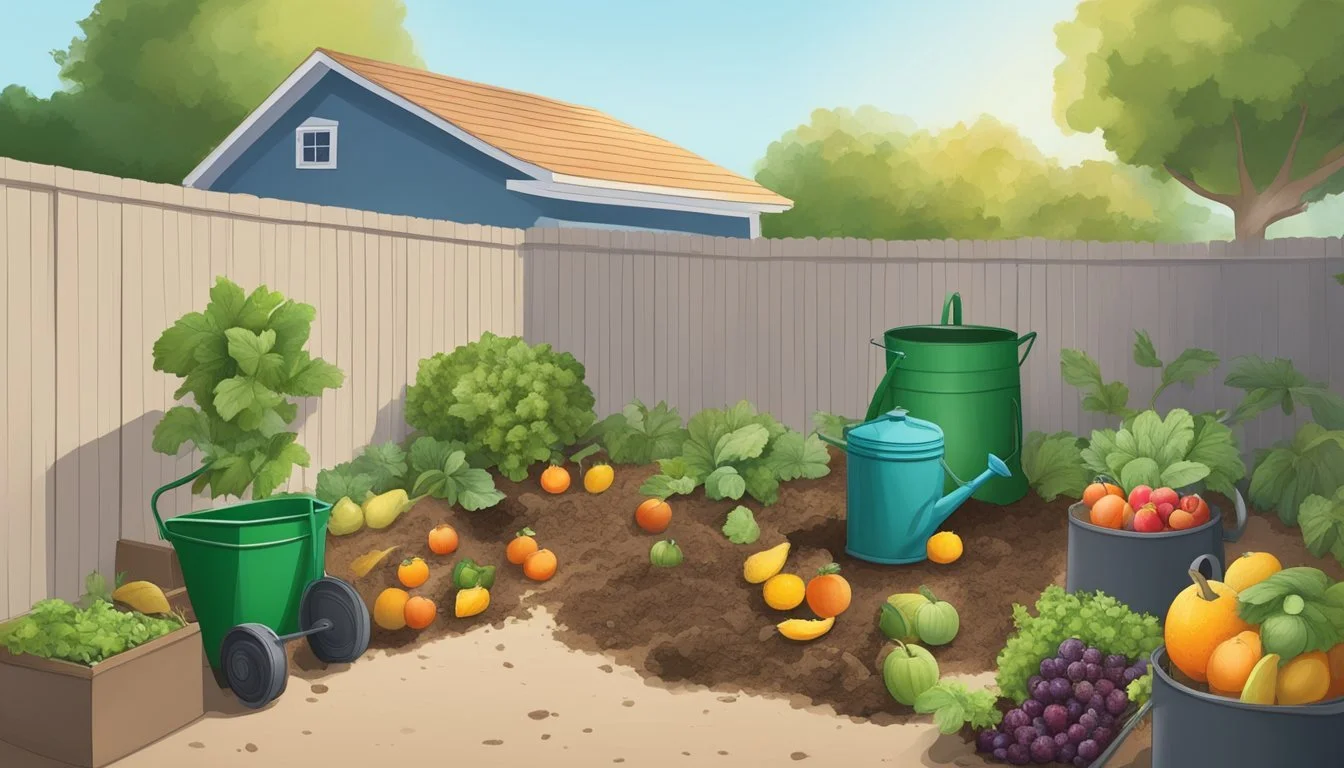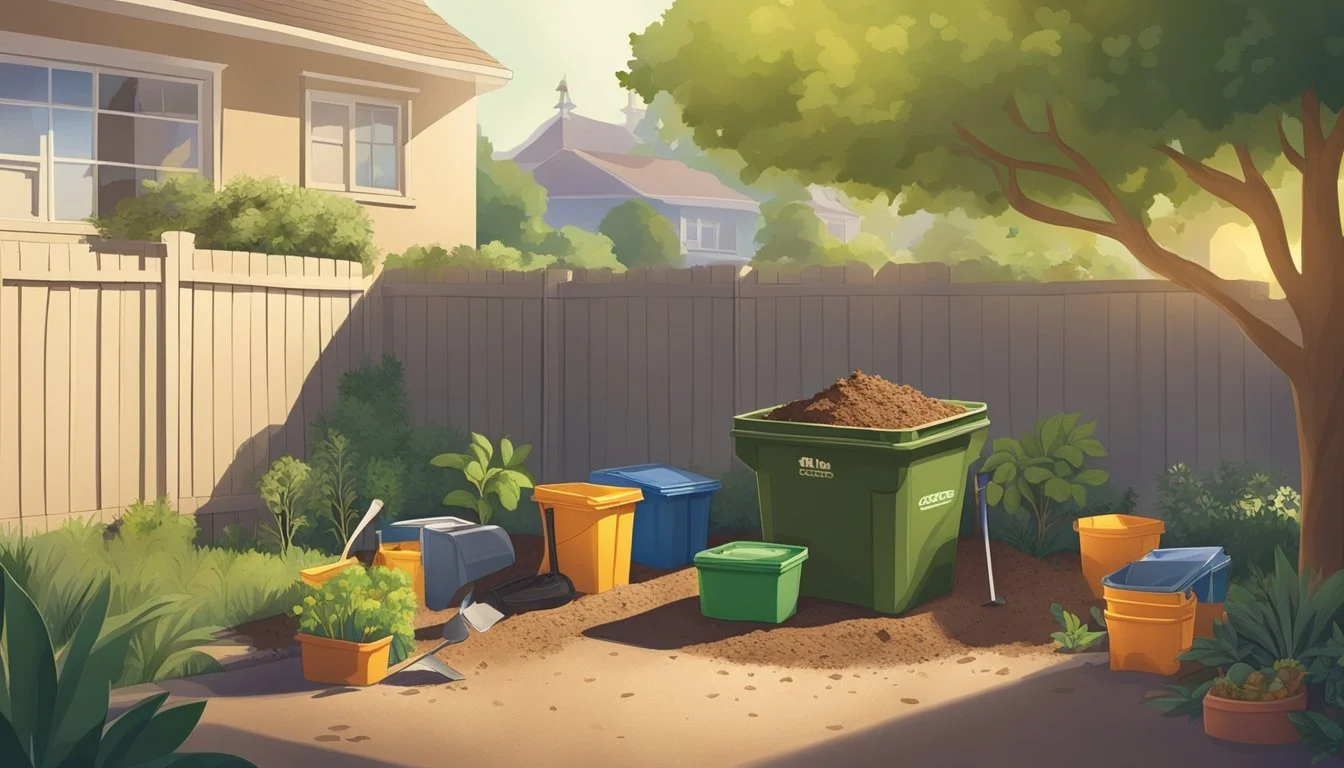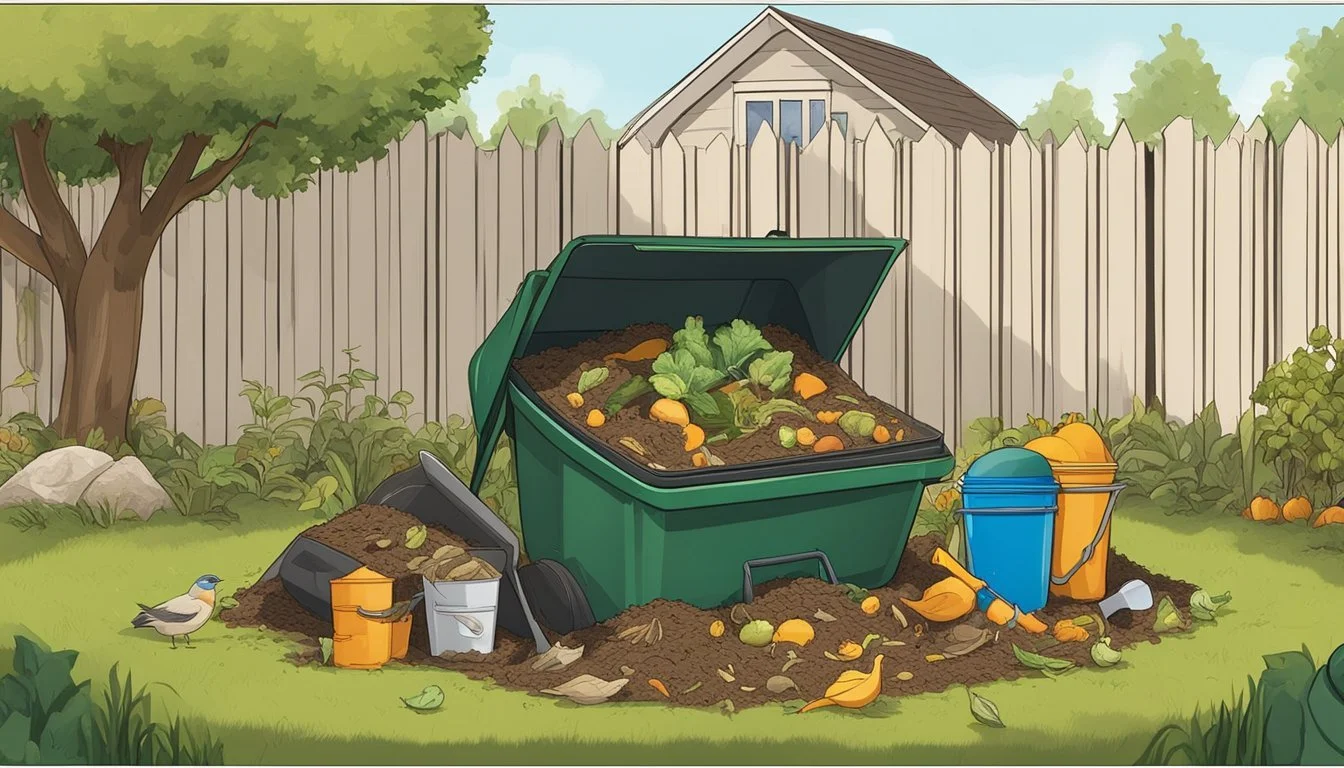Guide to Composting in Burbank, CA
Essential Tips for Eco-Friendly Waste Reduction
Composting is an eco-friendly practice that transforms organic waste into valuable fertilizer, enhancing soil quality and reducing waste in landfills. In Burbank, California, the City's Public Works Department provides its residents with extensive composting resources and services. These efforts not only support local gardeners but also contribute to the broader sustainability goals of the community.
The City of Burbank encourages residents to engage in composting by offering instructions and materials, including a free kitchen food scrap collection pail. They emphasize the importance of composting as a means of recycling organic materials such as yard waste and food scraps, which in turn, helps to reduce the burden on local waste management systems and promotes soil health in urban gardens.
Through initiatives like the Burbank Recycle Center and various educational guides, the city aims to make composting an accessible and routine activity for all its residents. Understanding the critical role composting plays in resource conservation, Burbank ensures that community members have the required knowledge and tools to integrate sustainable practices into their daily lives.
Basics of Composting
Before delving into the world of composting, it's important to understand its core principles and benefits. Composting is an essential practice for anyone interested in transforming organic waste into valuable amendments for soil health.
What Is Composting?
Composting is the process by which organic material degrades naturally, converting waste into a nutrient-rich soil amendment known as compost. Microorganisms, fungi, and other decomposers break down organic matter in a controlled environment. The City of Burbank encourages residents to participate in composting to reduce waste and improve soil quality.
Benefits of Composting
Composting offers numerous benefits, both environmentally and for garden health. It enriches the soil, helping retain moisture and suppress plant diseases and pests. Through recycling organic matter, composting reduces the need for chemical fertilizers while cutting methane emissions from landfills, thus contributing positively to the effort against climate change.
Compostable Material Overview
The key to successful composting lies in understanding which materials are compostable. Here's a simplified view:
Greens: Such as vegetable and fruit scraps, coffee grounds, and fresh grass clippings, provide nitrogen.
Browns: Including dry leaves, branches, and twigs, offer carbon.
Water: Maintains moisture to help break down materials.
Materials to avoid in your compost bin include meats, dairy products, fats, oils, and diseased plants. These can attract pests and cause odors. For more on composting workshops and acceptable materials, visit Burbank Recycle Center's official compost guide.
Composting in Burbank aligns with statewide initiatives to promote organics recycling and reduce waste, as demonstrated through the city's expanded Green Cart collection program.
Setting Up Your Composting System
Setting up an efficient composting system is key to managing organic waste in Burbank, CA. Choosing the proper location and container, as well as effectively creating the compost pile, are essential for successful backyard composting.
Choosing the Right Location
Selecting an appropriate site for composting is crucial. The site should be flat, well-drained, and receive a mix of shade and sunlight. It should be convenient to access, but away from direct contact with neighbors to avoid any disturbance. The area should also be large enough to accommodate the compost pile and potential expansion.
Selecting a Composting Container
Composting can be accomplished in various containers, from a simple green cart provided by the City of Burbank, to a specifically designed compost bin. The size of the container is important; it needs to be large enough to hold your organic waste while allowing for aeration and proper decomposition.
Materials: Choose durable materials like plastic, metal, or wood.
Vents/Screens: Ensure the container has proper ventilation and screen openings to promote air flow and keep pests out.
Lid: A lid is necessary to discourage animals and reduce odor.
Creating the Compost Pile
Constructing the compost pile begins by layering brown and green materials. Browns are carbon-rich materials like leaves and twigs, while greens are nitrogen-rich like food scraps and lawn clippings.
Base Layer: Start with brown materials to establish a foundation for drainage and aeration.
Add Greens: Layer green materials next to introduce the necessary nitrogen.
Alternate Layers: Continue alternating layers of greens and browns.
Size: Keep pile size manageable; ideally, a pile should be no smaller than 3 feet by 3 feet and no larger than 5 feet in any direction for optimal heating and decomposing.
Moisture: Your pile should be as moist as a wrung-out sponge to support the composting organisms.
Regular maintenance, including turning the pile and monitoring its moisture, is paramount to transform your organic waste into nutrient-rich compost for your garden.
What to Compost
A successful composting process relies on balancing nitrogen-rich green materials with carbon-rich brown materials, while ensuring certain items are kept out of the compost pile to avoid contamination and inefficiency.
Green Materials for Nitrogen
Green materials provide nitrogen, which is essential for compost microorganisms. These materials include:
Fruit scraps: Apples, oranges, bananas, etc.
Vegetable scraps: Carrot peels, lettuce, and other vegetable remnants.
Coffee grounds: A nitrogen-rich addition that also helps to reduce the pile's pH.
Eggshells: Provide both nitrogen and calcium, which is beneficial for plants.
These materials should be added to the compost in balance with brown materials to create a nutrient-rich compost.
Brown Materials for Carbon
Brown materials add carbon, which fuels decomposition and provides energy for compost microorganisms. Examples of brown materials are:
Leaves: Fallen leaves can be collected and added to the pile.
Brush: Small branches and twigs help to aerate the pile.
Untreated wood: Sawdust or chips from untreated wood are excellent carbon sources.
Paper and cardboard: Shredded newspaper and brown corrugated cardboard without inks or dyes.
Carbon materials should be larger in volume compared to green materials to maintain the correct balance in the compost.
Items to Exclude from Your Compost
Not everything can be composted safely or effectively. The following items should not be included in compost:
Dairy products: Can lead to unpleasant odors and attract pests.
Meat and animal-derived products: These can also attract pests and cause odors.
Pet waste: Never add cat or dog waste, which can contain pathogens.
Compostable plastics: These do not break down in a home composting system.
Soiled paper products: These may contain contaminants and are best recycled separately.
How to Compost
Composting is a precise process involving the balance of organic materials, moisture, and temperature to produce fertile soil. Successful composting in Burbank, CA, harnesses the natural decay of organic matter while managing key factors like aeration and moisture levels.
Layering Your Compost
For the compost to break down effectively, one must layer green materials rich in nitrogen such as food scraps or grass clippings, with brown materials high in carbon like dry leaves or branches. To maintain a balance, aim for roughly a 25-30:1 ratio of carbon to nitrogen. This optimal ratio fast-tracks the decomposition, resulting in healthier compost.
Maintaining Moisture and Aeration
Moisture is crucial for the microbial activity that breaks down compost materials. The compost pile should be as wet as a wrung-out sponge—an optimal moisture level of 40-60% is ideal. To ensure good aeration, turning the compost regularly prevents pockets of anaerobic conditions that can slow down the process and cause unpleasant odors.
Managing Compost Temperature
The temperature within a compost pile should remain between 135-160 degrees Fahrenheit to destroy pathogens and weed seeds effectively. A consistent temperature also encourages quick and even decomposition. Monitoring the temperature with a compost thermometer can indicate when to turn the pile to redistribute heat.
Knowing When Compost Is Ready
Finished compost appears dark, crumbly, and smells earthy, usually taking 3-6 months to reach this stage. It's neither too wet nor dry and should hold its structure when squeezed. Before applying to the garden, one should ensure the compost has cooled down and material is no longer recognizable; this signifies that the nutrient-rich amendment is ready to use.
Troubleshooting Common Issues
Composting in Burbank can hit snags such as unpleasant smells and uninvited pests. A successful composting process relies heavily on maintaining proper balance and conditions within the compost pile.
Odor Problems
Unpleasant Odors: If the compost pile emits a rotten eggs odor, it's often due to lack of air, leading to anaerobic decomposition. Turning the pile to introduce oxygen can quickly alleviate this problem. Conversely, an ammonia-like smell suggests an excess of nitrogen-rich 'greens'. Balancing the pile with more carbon-rich 'browns' like dry leaves or straw can remedy this issue.
Pest Issues
Attracting Pests: Preventing pest invasions requires avoiding certain materials in the compost bin, such as bones, dairy, or oils. Enclosed compost tumblers or bins, along with frequent turning and covering with a tarp when necessary, are effective strategies. The City of Burbank offers resources that may include free food scrap collection pails to help maintain a clean and contained composting system.
Using Your Finished Compost
Once compost reaches a dark, crumbly state with an earthy odor, it’s ready to enrich the soil. Proper utilization ensures that plants receive vital nutrients for healthy growth.
Garden Application
Finished compost acts as a superb soil amendment for garden beds, improving soil structure and fertility. It should be mixed into the top few inches of the soil before planting, providing a rich source of nutrients that helps plants thrive.
Lawn Care
For lawns, compost can be used as a natural mulch or soil conditioner. It's applied by thinly spreading it across the lawn, aiding in water retention and providing grassroots with nourishing minerals that promote robust growth and greening.
Houseplants and Containers
Incorporating compost into potting mix for houseplants rejuvenates the existing soil and gradually releases nutrients which helps maintain their health. Aim for a small portion mixed into the potting soil to avoid overpowering the plants.
Community Projects
Compost contributes significantly to community gardens, where it enhances communal planting spaces. It serves to not only improve plant health and soil quality but also fosters a sustainable cycle of organic waste reuse within the community.
Advanced Composting Techniques
In advanced composting, one harnesses specialized methods to accelerate decomposition and enhance the end product. Techniques such as vermicomposting and Bokashi fermentation represent innovative ways to manage organic waste effectively.
Vermicomposting
Vermicomposting involves the use of worms, typically red wigglers, to convert organic waste into nutrient-rich compost. The process is suited for indoors or outdoors and can handle kitchen scraps, paper, and small amounts of yard waste. Burbank residents can enhance their composting efforts by setting up a worm bin, where the worms break down the material in a contained environment. Key factors to monitor in vermicomposting include:
Moisture: Keep the bin moist but not overly saturated.
Temperature: Maintain a temperature between 55-77 degrees Fahrenheit (13-25 Celsius) for optimal worm activity.
Aeration: Regularly fluff the bin to allow oxygen to circulate.
By controlling these parameters, one can ensure a successful vermicomposting process, yielding compost that is excellent for enhancing soil fertility.
Bokashi Fermentation
Bokashi fermentation differs from traditional composting methods because it is an anaerobic process, meaning it occurs in the absence of air. It employs a mix of microorganisms to ferment organic material, including dairy and meats which typically do not go in a traditional compost pile. This method is quick, usually taking about two weeks to complete the initial fermentation, after which the material can be buried in soil to finish the process.
For Bokashi fermentation:
Layer your kitchen scraps with Bokashi bran in a sealed container.
Press down to remove air and seal tightly after each addition.
After the container is full, let it sit for two weeks, then bury the contents in soil.
This approach can be particularly useful for individuals living in urban environments like Burbank, where space for traditional composting may be limited. Bokashi fermentation is an efficient way to reduce waste and create a valuable amendment for plants and gardens.
Composting Regulations in Burbank
Burbank's composting regulations align with state mandates to reduce organic waste and support environmental sustainability. The city provides resources to ensure residents can participate effectively in organic waste diversion efforts.
Municipal Composting Programs
The City of Burbank offers composting programs to promote the recycling of organic materials. This initiative supports the natural process of turning organic waste into nutrient-rich compost. Detailed information about Burbank's efforts can be found on the Public Works Department's Composting page. Residents are encouraged to use their green cart collection service for yard trimmings and food scraps.
Compliance with SB 1383
Compliance with Senate Bill 1383 (SB 1383) is essential, as it lays out rigorous statewide goals to reduce the disposal of organic waste. The City of Burbank is actively taking steps to meet these obligations by providing services and education to facilitate organics recycling which includes both compostable materials and other forms of organic waste.
Acquiring a Green Cart
Residents can acquire a green cart for organics recycling, which is critical in adhering to Burbank's waste reduction strategies. For details on what is permitted in the green carts and how to maintain them, refer to the guidelines provided here. Proper use of the green cart supports the city's environmental goals and compliance with state regulations.
Reducing Waste Beyond Composting
While composting tackles organic waste, comprehensive waste reduction in Burbank, CA incorporates other materials unsuitable for compost. Proper recycling and contamination avoidance further streamline this sustainable approach.
Recycling Materials Not Suited for Composting
Certain waste items do not decompose appropriately in a composting environment but can be effectively recycled. Residents should separate plastics, metals, glass, and paper from their compostables, placing them in designated recycling containers. The City of Burbank provides clear instructions on residential recycling processes to ensure efficient material recovery.
Plastic bags, often a contaminant in green carts, should be kept out of both recycling and compost bins. Special drop-off locations are available for plastic bags to prevent them from entering the waste stream improperly.
Avoiding Contamination in the Green Cart
To maximize the success of Burbank's organics recycling program, minimizing contamination in the green cart is crucial. Residents are encouraged to avoid tossing plastic bags, garbage, and non-organic materials into their green carts. Strict adherence to the guidelines provided on organics recycling ensures that collected organic material is compostable and not redirected to the landfill due to contamination.
By maintaining vigilance in separating waste, Burbank not only extends landfill life but also creates a cleaner environment and a more sustainable future.
Resources and Education
In Burbank, California, residents have access to a variety of resources and education opportunities aimed at enhancing composting efforts. The city takes pride in its composting program and offers multiple avenues for individuals to learn and participate.
Local Workshops and Events
The Burbank Recycle Center is a key player in the city's composting education. It hosts composting workshops throughout the year, providing hands-on training to residents. These events allow participants to learn the ins and outs of composting, including how to handle compostable plastics. Interested individuals can learn more about Burbank compost workshops at the Recycle Center's official site.
Upcoming Events:
Compost Workshop: Date TBD
Recycling Q&A: Date TBD
Online Guides and Tutorials
For those unable to attend local events or preferring to learn at their own pace, the City of Burbank offers online educational resources. These include comprehensive guides and tutorials on how to start and maintain a home composting system effectively. The Burbank Recycle Center's Organics Recycling page is an excellent starting point for virtual learners, providing detailed information and tips on organics recycling and composting.
Available Resources:
Composting Guide: Step-by-step instructions on creating and managing compost
Recycling Dos and Don'ts: Clarifications on compostable materials
Residents are encouraged to take advantage of these resources to enhance their composting knowledge and practices.










